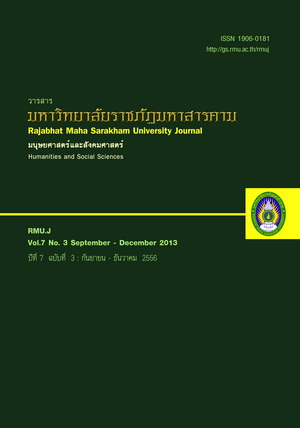การประเมินระบบประเมินผลทุนหมุนเวียนในประเทศไทย
Main Article Content
บทคัดย่อ
บทคัดย่อ
การวิจัยนี้มีวัตถุประสงค์ ประการแรก เพื่อพัฒนา ตรวจสอบคุณภาพและประยุกต์ใช้ตัวแบบมาตรฐานการประเมินงานประเมิน (Meta-evaluation standards) สำหรับประเมินคุณภาพรายงานการประเมินผลทุนหมุนเวียนในประเทศไทย ประการที่สอง เพื่อตรวจสอบ และสังเคราะห์เนื้อหารายงานการประเมินผลในประเด็นจุดแข็ง จุดบกพร่อง และ ประการที่สาม เพื่อเสนอแนะรูปแบบการประเมินผล ทุนหมุนเวียนที่เหมาะสมกับประเทศไทย แหล่งข้อมูลการวิจัยคือรายงานการประเมินผลทุนหมุนเวียน ประจำปีบัญชี 2554 จำนวน 81 ทุน และทำการเก็บข้อมูลเชิงคุณภาพเพิ่มเติมด้วยวิธีการสัมภาษณ์ผู้ให้ข้อมูลสำคัญ เครื่องมือที่ใช้ในการวิจัย คือแบบมาตรฐานการ ประเมินงานประเมิน วิเคราะห์ข้อมูลด้วยสถิติพื้นฐาน ได้แก่ ความถี่ ร้อยละ ค่าเฉลี่ย ส่วนเบี่ยงเบนมาตรฐาน วิเคราะห์องค์ประกอบ ของตัวบ่งชี้ ในมาตรฐานการประเมินงานประเมินโดยเทคนิควิเคราะห์องค์ประกอบหลัก (Principal component analysis) แนวคิด และทฤษฎีที่ใช้ในการวิจัยได้แก่ การประเมินผล Balanced scorecard การประเมินงานประเมิน (Meta-evaluation) การนำผลการ ประเมินไปใช้ประโยชน์ เป็นต้น
ผลการศึกษาวิจัยพบว่า ตัวแบบมาตรฐานการประเมินงานประเมิน ประกอบด้วย 49 ตัวบ่งชี้ในมาตรฐานการประเมิน 5 มาตรฐาน ได้แก่ ความตรงของการประเมิน อรรถประโยชน์ จริยธรรมในการประเมิน ความน่าเชื่อถือของนักประเมิน และประสิทธิผลต้นทุน สำหรับการประยุกต์ใช้ตัวแบบมาตรฐานการประเมินงานประเมินกับกลุ่มตัวอย่าง จำนวน 50 ทุน พบว่า ส่วนใหญ่มีคุณภาพอยู่ในระดับ พอใช้ จำนวน 19 ทุน (38%) ผลการประเมินมีคุณภาพอยู่ในระดับดี จำนวน 14 ทุน (28%) ผลการประเมินมีคุณภาพอยู่ในระดับดีมาก จำนวน 14 ทุน (28%) และผลการประเมินมีคุณภาพอยู่ในระดับยอดเยี่ยม จำนวน 3 ทุน (6%) และผลการสังเคราะห์เนื้อหารายงาน การประเมินผลทุนหมุนเวียนจากประชากรทั้งหมด 81 ทุน พบว่า เป็นประเด็นจุดแข็งเชิงโครงสร้างเนื้อหาเป็นส่วนใหญ่และพบประเด็น จุดแข็งในเชิงวิเคราะห์เป็นส่วนน้อย
ส่วนประเด็นจุดบกพร่องที่สำคัญพบว่า ทั้งหมดไม่มีการนำเสนอบทสรุปสำหรับผู้บริหาร ขาดบทสรุปและบทวิเคราะห์และ ประมวลผลการประเมิน รวมทั้ง ขาดการนำเสนอประเด็นปัญหาหลักและข้อเสนอแนะจากการประเมิน เป็นต้น สำหรับข้อเสนอรูปแบบ ระบบประเมินผลทุนหมุนเวียนที่เหมาะสมกับประเทศไทยนั้น ผู้วิจัยนำเสนอองค์ประกอบสำคัญ 4 องค์ประกอบ ได้แก่ 1) การเตรียม ความพร้อมเข้าสู่ระบบประเมินผล 2) การออกแบบระบบประเมินผล 3) การรายงานผลการประเมินและระบบแรงจูงใจ 4) การประเมิน งานประเมิน
คำสำคัญ : ระบบประเมินผลทุนหมุนเวียน, การประเมินงานประเมิน, มาตรฐานการประเมินงานประเมิน
ABSTRACT
The purposes of this research are: 1) to develop, validate, and apply the meta-evaluation standards for an evaluation of the evaluating system in Thai revolving-funds, 2) to investigate and analyze assessment reports of the evaluating system for its weaknesses and strengths, and finally 3) to recommend the better form of the evaluating system. These data were collected from 81 revolving-funds assessment reports of the fiscal year 2011. However, some key informantion for this research, qualitative data, was collected by indepth interviews. The model of this research is the meta-evaluation standards. An analysis of quantitative data was conducted by using frequency, percentage, mean, standard deviation, t-test, and principal component analysis. Concepts and theories for this research base on evaluation, balanced scorecard, meta-evaluation, theory of utilization, etc.
The result of this research reveals that the better form of this meta-evaluation standards consisted of 49 indicators which could be grouped into 5 categories; 1) validity 2) utility 3) ethicality 4) credibility and 5) cost-effectiveness. After testing the meta-evaluation standards with 50 assessment reports, the research found that; 19 reports were in the fair level (38%), 14 reports were in the good level (28%), 14 reports were in the very good level (28%), and 3 reports were in the excellent level (6%). Moreover, the result of investigating and analyzing 81 revolving-funds assessment reports of the fiscal year 2011 indicated the strength of their basic content structure, and the weakness of their executive summary. Their mojor missing points in each individual revolving-fund report were critic, conclusion, and recommendation. The research recommends that the valid evaluating system in Thai revolving funds consists of 4 elements; 1) preparation for using the evaluating system in the revolving funds, 2) designing the evaluating system, 3) reporting the results of the evaluation and building motivation mechanism, and lastly 4) the meta-evaluation.
Keywords : Evaluating System in Revolving-Funds, Meta-Evaluation, Meta-Evaluation Standards
Article Details
1. บทความที่ลงตีพิมพ์ทุกเรื่องได้รับการตรวจทางวิชาการโดยผู้ประเมินอิสระ ผู้ทรงคุณวุฒิ (Peer Review) สาขาที่เกี่ยวข้อง อย่างน้อย 3 ท่าน ในรูปแบบ Double blind review
2. ข้อคิดเห็นใด ๆ ของบทความที่ลงตีพิมพ์ในวารสารมหาวิทยาลัยราชภัฏมหาสารคาม นี้เป็นของผู้เขียน คณะผู้จัดทำวารสารไม่จำเป็นต้องเห็นด้วย
3. กองบรรณาธิการวารสารมหาวิทยาลัยราชภัฏมหาสารคาม ไม่สงวนสิทธิ์การคัดลอกแต่ให้อ้างอิงแสดงที่มา


